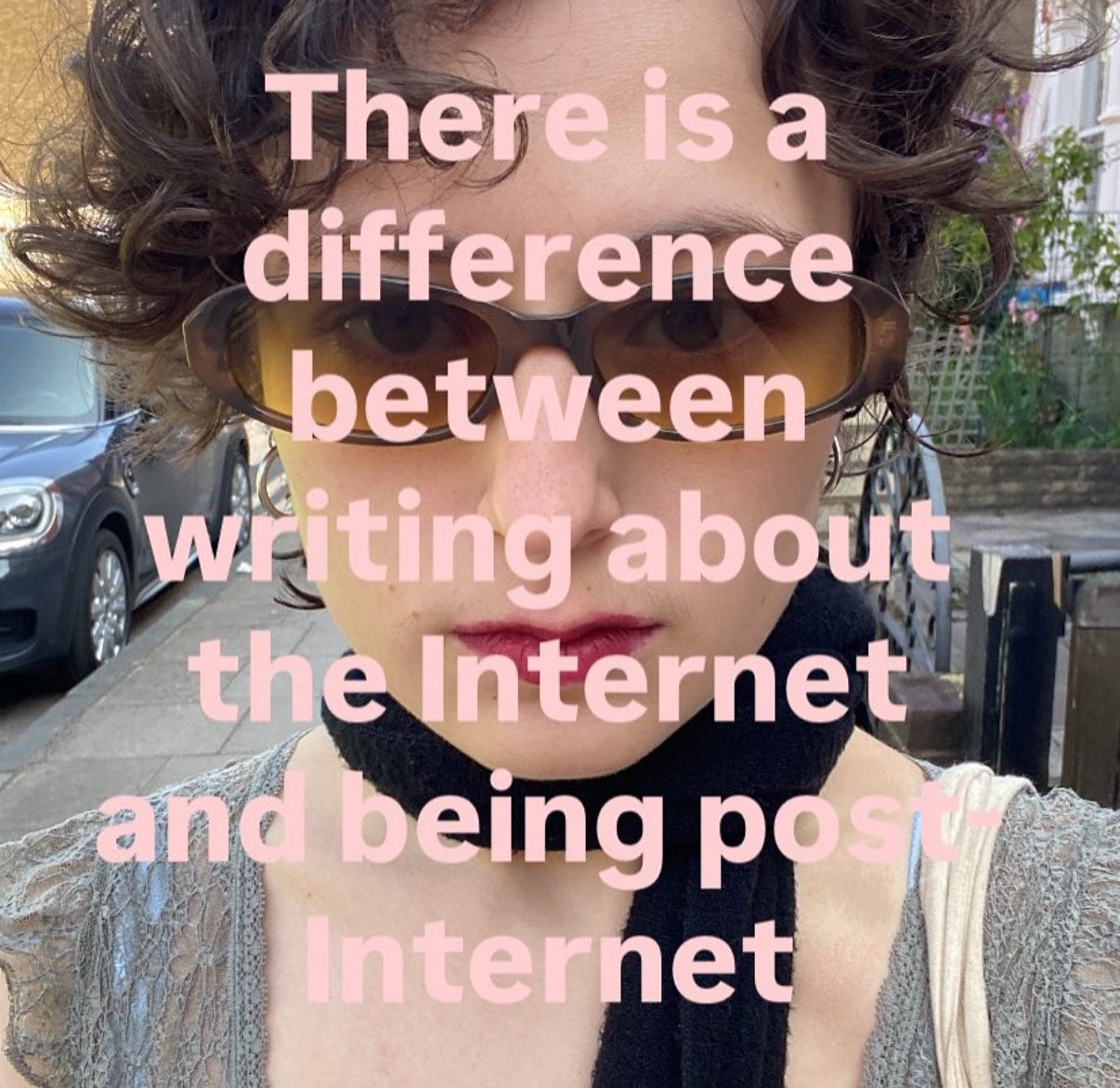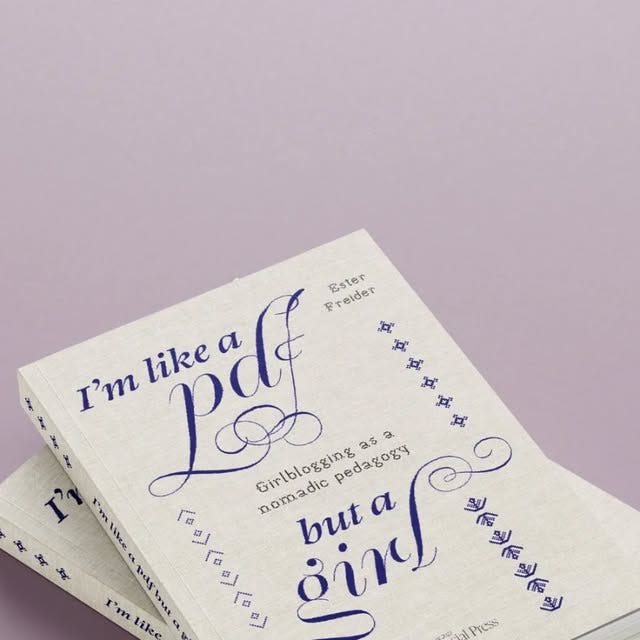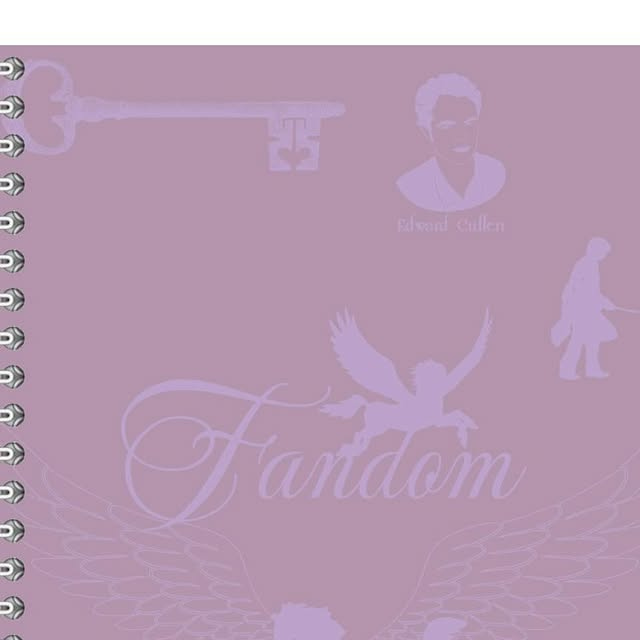Seduction, fandom, and performance: Ester Freider on everyone is a girl
The collective spans an Instagram meme page, zines, a Substack publication, Are.na page, and in-person events.
Today’s issue of PHONE TIME features a conversation with Ester Freider about everyone is a girl, a collective “focused on the relationship between femininity and internet culture.”

Over the summer, I spoke with Ester Freider, a writer, curator, and a creator of everyone is a girl. First launched in December 2023, EIAG describes itself as a forum for “jagged and iridescent reflection on the ‘girl online,’ or rather, the necessity of being a girl online.” The multimedia project, informed by cyberfeminist tradition, spans print zines, digital publications, and events. In September, the collective hosted “PORNO CHIC: An interdisciplinary symposium on porn, sex work, art, and queerness,” and a recording of the event is available here.
This conversation has been edited for clarity and length.
PHONE TIME: How did your work on girlhood and EIAG begin?
ESTER FREIDER: I went to Central Saint Martins, and then I went to University College London. In that time, I started doing a lot of independent projects and making events. I was really interested in posthumanism and stuff like that at the beginning. I was reading Donna Haraway and Sadie Plant. I started writing about the internet as well. I wrote my bachelor’s thesis about Tumblr. Then I found out from that, that there was actually a bunch of different people doing similar work and writing about being a girl online—Rayne Fisher-Quann, Mindy Seu, Legacy Russell.
When I also posted it on Are.na, it got a lot of traction, which was really cool. I started my master’s, which was not as much work as I thought it would be. So I had some time on my hands, and I wanted to make a book about this: a girl-internet book. It happened to also be when this was reaching a pinnacle on a broader cultural scale. Alex Quicho wrote her article, “Everyone Is A Girl Online,” in September 2023.
I got some designers, and we were like, “Let’s do it. But first, before we make a book, we have to make a platform, and get an audience. And if we want to apply to grants, we already have to have work to apply to the grants with.” And then we started doing stuff, and then we forgot about the book.
PHONE TIME: How would you describe the overall project of EIAG?
FREIDER: To me, it’s like an art project. It’s a performance project. I don’t think I would call it research, I think I would have trouble using that word. But we kind of parody, with love, a lot of pseudo-academic themes and ideas. Like the idea of having a symposium or the idea of making a publication, where everybody has biographies. At the same time, we’re also parodying a meme page. But then it also becomes something else, because everything is so theoretically linked.
PHONE TIME: Tell me a little about the EIAG zines—”Seduction” and “Fandom.”
FREIDER: “Seduction” we did in May 2024, and “Fandom” was in October 2024. We did an open call process for both of them. It was surprising how many people wanted to participate and how little of them were from London as well. We got a lot of international attention. The seduction thing, I feel like that really encompasses what Alex Quicho was talking about. It’s very much like the core idea. So it was really nice to start with that and just straight up turn her thesis into this sort of rhizomatic project with contributors.
“Fandom” was more like my pleasure, because it’s a little more indulgent. It was just playing on 2010s revival. I wanted at first to do Dan and Phil—literally just Dan and Phil. I was convinced out of that. It was a little bit more of like, now that we have all these people that we know and who like what we do—let’s do something that would be really fun and nostalgic for them.
PHONE TIME: How do you think about the design of the EIAG projects?
FREIDER: I think we were really thinking about early internet aesthetics. There’s a lot of ASCII and stuff, and also combining that with hyperfeminine energy. But at the same time, making it delicate and minimal.
On the first one, in the print edition, Jules Halasy actually made an embossment design. And we designed it so there’s a butterfly. We wanted it to feel fluffy. Basically as fluffy as a bunch of pieces of paper could feel fluffy and cake-like.
With “Fandom,” it was going toward a more journal-y vibe. It looked very back-to-school.
“We discard the priority/possibility of authenticity online, if at all. Instead we yield to the pearly cavern of artifice, play, and swarm that might reveal that there was no true self in the first place.” — everyone is a girl
PHONE TIME: Why do you think EIAG has gotten such a response, both to your online and in-person projects?
FREIDER: I think it’s partially because of the way that the meme stuff I do works. Very deliberately from the beginning, I always would look through who follows us, and pull from their meme page or whatever was on their story. I was like, “You are now a part of this thing.” And I think people liked that. And because all these more famous writers, artists were posting the originals, to have that all collated in one place was really interesting for me. I honestly think the meme stuff is like the main draw.

Read more







